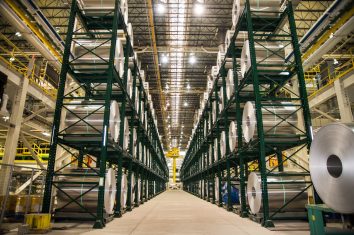Pallet Rack Manufacturing: An Overview
Pallet racks are essential components of warehouse storage systems, designed to optimize space and facilitate efficient inventory management. The manufacturing of pallet racks involves a series of complex processes and considerations to ensure the final product meets industry standards and customer needs. This article explores the key aspects of pallet rack manufacturing, including the types of racks, materials used, manufacturing processes, and quality control measures.
Types of Pallet Racks
-
Selective Racks: These are the most common type of pallet racking systems, offering direct access to each pallet. They are ideal for warehouses with a wide variety of products and high inventory turnover. Selective racks are typically made from high-strength steel and feature adjustable beams to accommodate different pallet sizes.
-
Drive-In/Drive-Through Racks: These racks are designed for high-density storage. They allow forklifts to enter the rack structure, enabling multiple pallets to be stored in a single location. Drive-in racks are useful for storing large quantities of similar products, while drive-through racks provide access from both ends, enhancing flexibility.
-
Push Back Racks: This type of racking system uses a system of carts and rollers to store pallets in a way that they are automatically pushed back as new pallets are loaded. This system improves space utilization and is suited for warehouses with a high volume of similar products.
-
Cantilever Racks: Cantilever racks are designed for storing long, bulky items such as pipes, lumber, or tubing. They feature horizontal arms that extend from a vertical column, allowing easy access and visibility of stored items.
-
Pallet Flow Racks: These racks use gravity to move pallets from the loading end to the picking end. They are designed for high-density storage and facilitate a first-in, first-out (FIFO) inventory management system.
Materials Used
-
Steel: The primary material used in pallet rack manufacturing is steel due to its strength and durability. Steel racks can withstand significant loads and are resistant to wear and tear. High-strength, cold-rolled steel is commonly used for the structural components of pallet racks.
-
Powder Coating: To enhance the appearance and durability of pallet racks, manufacturers apply a powder coating. This process involves applying a dry powder to the metal surface, which is then cured under heat. The coating provides a protective layer that resists scratches, corrosion, and fading.
-
Other Materials: In some cases, manufacturers may use other materials such as aluminum for lighter applications or plastic components for specific parts of the racking system. However, steel remains the most prevalent material due to its cost-effectiveness and strength.
Manufacturing Processes
-
Design and Engineering: The manufacturing process begins with designing the pallet rack system. Engineers use computer-aided design (CAD) software to create detailed blueprints, ensuring that the racks meet load-bearing requirements and spatial constraints. The design process also involves selecting appropriate materials and determining the dimensions of the racks.
-
Fabrication: Once the design is finalized, the fabrication process begins. Steel sheets are cut, bent, and welded to form the various components of the rack. This process involves precise measurements and high-quality welding techniques to ensure structural integrity.
-
Assembly: After fabrication, the individual components are assembled into complete rack systems. This involves attaching beams, columns, and other structural elements. Assembly can be done manually or using automated systems, depending on the scale of production.
-
Finishing: The racks undergo a finishing process to enhance their appearance and durability. This includes powder coating to provide a smooth, protective layer on the steel surface. Some manufacturers also perform additional treatments, such as galvanizing, to further protect against corrosion.
-
Quality Control: Quality control is a critical aspect of pallet rack manufacturing. Manufacturers conduct various tests to ensure that the racks meet safety and performance standards. This includes load testing, structural integrity checks, and inspections for defects. Compliance with industry standards, such as those set by the Rack Manufacturers Institute (RMI), is also verified.
Industry Standards and Safety
Pallet racks must adhere to various industry standards to ensure safety and performance. The Rack Manufacturers Institute (RMI) provides guidelines and standards for the design, manufacturing, and installation of pallet racks. Compliance with these standards helps prevent accidents and ensures that the racks can safely support the intended loads.
Manufacturers also need to consider factors such as seismic considerations, fire safety, and ergonomic design. Proper installation and maintenance are essential to ensure the racks remain safe and functional throughout their lifecycle.
Conclusion
Pallet rack manufacturing is a complex process that involves careful design, material selection, fabrication, assembly, and quality control. The goal is to produce robust, reliable, and efficient storage solutions that meet the needs of modern warehouses and distribution centers. By adhering to industry standards and continuously improving manufacturing practices, pallet rack manufacturers play a crucial role in optimizing warehouse operations and supporting the logistics industry.
